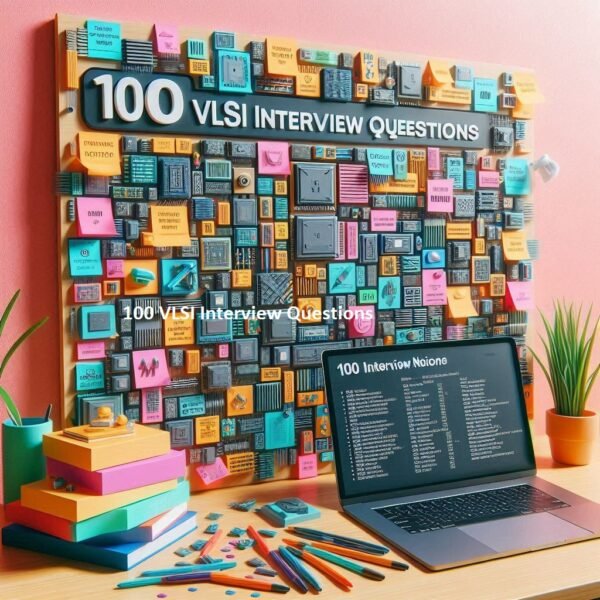100 VLSI Interview Questions

Fundamental VLSI Concepts:
What is VLSI, and why is it important?
Explain Moore’s Law.
Describe the differences between ASIC and FPGA.
What are the main VLSI design flow steps?
Explain the differences between combinational and sequential logic.
What are the different types of power dissipation in VLSI circuits?
Explain the different fabrication processes in VLSI.
CMOS and Transistors:
Explain the operation of a MOSFET.
Describe the different regions of MOSFET operation.
What is CMOS technology, and why is it preferred?
Explain the concept of threshold voltage.
What are pull-up and pull-down networks in CMOS?
Digital Design:
What are logic gates (AND, OR, NOT, NAND, NOR, XOR, XNOR)?
Explain flip-flops and latches (SR, JK, D, T).
What are registers, counters, multiplexers, and demultiplexers?
Describe state machines (Moore, Mealy).
Explain clock domain crossing (CDC) and its challenges.
What are setup and hold time violations, and how are they resolved?
What is RTL design?
What is the difference between synchronous and asynchronous reset?
Physical Design:
What is floorplanning, placement, and routing?
Explain clock tree synthesis.
What is static timing analysis (STA)?
What is the significance of parasitic extraction?
What are design rule checks (DRC) and layout versus schematic (LVS) checks?
What is signal integrity?
What is power optimization?
Verification:
What are different verification methodologies (simulation, formal verification)?
What is the role of hardware description languages (Verilog, VHDL)?
What is the concept of test benches?
Advanced Topics:
Explain advanced node technologies.
Describe memory design (SRAM, DRAM, ROM).
Discuss low-power design techniques.
Explain the challenges of high-speed interface design.
Tips for VLSI Interviews:
Strong Fundamentals: Ensure a solid understanding of basic VLSI concepts.
Practical Knowledge: Be prepared to discuss real-world applications and design scenarios.
Problem-Solving: Practice solving logic design and timing analysis problems.
Tool Familiarity: If applicable, be familiar with industry-standard VLSI design tools.
Stay Updated: Keep abreast of the latest advancements in VLSI technology.
By focusing on these key areas, you’ll be well-prepared for most VLSI interviews.
Here are 100 VLSI (Very Large Scale Integration) interview questions, categorized into different topics:
1. CMOS & Digital Design
What is CMOS technology, and why is it widely used?
Explain the working of a CMOS inverter.
What is the difference between NMOS and PMOS transistors?
How do you size an inverter in CMOS design?
What is the noise margin of a CMOS inverter?
What is the difference between static and dynamic power dissipation?
How do you minimize leakage power in CMOS circuits?
What are the advantages of SOI (Silicon On Insulator) technology?
What is latch-up in CMOS? How do you prevent it?
Explain the concept of body effect in MOS transistors.
2. Fabrication & Process Technology
What are the key steps in CMOS fabrication?
What is the role of oxidation in IC fabrication?
What is ion implantation, and why is it important?
What is the purpose of a cleanroom in semiconductor manufacturing?
Explain the concept of doping in semiconductors.
What are different types of process nodes (e.g., 5nm, 7nm)?
How does FinFET technology differ from traditional planar MOSFETs?
What are the advantages of using high-k dielectrics?
What is the difference between BEOL and FEOL in semiconductor manufacturing?
What is the significance of shallow trench isolation (STI)?
3. Timing & Performance Analysis
What is setup time and hold time?
Explain the concept of clock skew.
What is the difference between positive and negative slack?
How do you resolve setup and hold violations?
What is the impact of process variations on timing analysis?
What are the primary sources of clock jitter?
What is the significance of the clock tree synthesis (CTS)?
Explain the difference between static and dynamic timing analysis.
What is meant by “pipelining” in digital circuits?
What is the importance of metastability in flip-flops?
4. Power & Low-Power Design
How do you reduce dynamic power consumption in VLSI circuits?
What is leakage power, and how do you mitigate it?
What is the significance of clock gating?
Explain the concept of power gating.
What are multi-Vt (multi-threshold voltage) techniques?
What is the difference between DVFS (Dynamic Voltage and Frequency Scaling) and AVS (Adaptive Voltage Scaling)?
What is the role of power domains in low-power design?
How does the power grid design impact IR drop?
What is meant by power-aware synthesis?
How do you estimate power consumption in VLSI circuits?
5. Physical Design
What are the main steps in physical design?
What is floorplanning in VLSI?
Explain the importance of placement in physical design.
What is clock tree synthesis (CTS), and why is it necessary?
What are routing congestion issues, and how do you resolve them?
What is an antenna effect in VLSI design?
What are metal layers in IC layout, and how are they used?
Explain the concept of Design Rule Check (DRC).
What is the role of Layout Versus Schematic (LVS) checks?
What are dummy fills in physical design?
6. ASIC vs FPGA
What is the difference between ASIC and FPGA?
When would you choose an FPGA over an ASIC?
What are the advantages of an FPGA?
Explain the difference between hard macros and soft macros.
How does an FPGA’s architecture differ from an ASIC?
What is the role of LUTs (Look-Up Tables) in FPGA design?
What is partial reconfiguration in FPGAs?
What is a bitstream in FPGA design?
How do you implement a state machine in FPGA?
What are the primary challenges in transitioning from FPGA to ASIC?
7. RTL Design & Verification
What is RTL design in VLSI?
What are the key differences between Verilog and VHDL?
How do you write an efficient FSM (Finite State Machine)?
What are blocking and non-blocking assignments in Verilog?
How do you avoid race conditions in Verilog?
What is the significance of testbenches in RTL verification?
What is code coverage in functional verification?
What is formal verification, and how is it used?
What are assertion-based verification techniques?
What is equivalence checking in RTL verification?
8. Design for Testability (DFT)
What is scan chain, and why is it used?
What is boundary scan testing?
How does Built-In Self-Test (BIST) work?
What is the difference between stuck-at faults and transition faults?
Explain the concept of ATPG (Automatic Test Pattern Generation).
What are common DFT techniques used in ASIC design?
What is JTAG, and how is it used in testing?
How does scan compression reduce test time?
What are the advantages of using MBIST (Memory BIST)?
What is fault coverage in VLSI testing?
9. Analog & Mixed-Signal Design
What is the difference between analog and digital design?
What is the role of PLL (Phase-Locked Loop) in VLSI?
How does an ADC (Analog-to-Digital Converter) work?
What are common noise sources in analog circuits?
What is slew rate in an op-amp?
How do you design a high-speed buffer?
What is meant by signal integrity in mixed-signal design?
Explain the role of a bandgap reference circuit.
What is a DAC (Digital-to-Analog Converter), and how does it work?
What are the key challenges in mixed-signal IC design?
10. Emerging Technologies & Trends
What is 3D IC technology, and what are its benefits?
What are chiplets, and how do they impact VLSI design?
What is quantum computing, and how does it differ from traditional computing?
Explain the concept of neuromorphic computing.
What is RISC-V, and why is it gaining popularity?
What is heterogeneous integration in semiconductor design?
How does AI/ML impact modern VLSI design?
What are the challenges in designing for automotive-grade semiconductors?
What are carbon nanotube transistors (CNTs), and how do they work?
What are the future trends in VLSI design?
Here are 100 VLSI interview questions categorized into various sections to help you prepare effectively for your interviews in the field of Very Large Scale Integration (VLSI):
Basic VLSI Interview Questions
What is VLSI, and how does it differ from ULSI?
Explain the difference between ASIC and FPGA.
What are the basic building blocks of a VLSI chip?
Define Moore’s Law and its significance in VLSI.
What is the depletion region?
What are the four generations of Integrated Circuits?
What is Verilog, and how does it differ from other standard programming languages?
What are the various modeling techniques used in Verilog?
Technical VLSI Interview Questions
What is the significance of slack in timing analysis?
Describe the differences between synchronous and asynchronous circuits.
What are metastability and its implications in digital circuits?
What is Clock Tree Synthesis, and why is it important in the physical design flow?
How would you minimize crosstalk in a high-speed digital design?
Explain the concept of clock domain crossing and how to handle it.
What are the challenges associated with scaling down transistor sizes in modern VLSI designs?
How do you make sure your RTL code is free from latches?
Design Engineer Interview Questions
Describe a challenging design problem you’ve encountered and how you solved it.
How do you approach power optimization in your designs?
What is your experience with design verification methodologies?
What is scan chain insertion, and why is it important in DFT?
Backend Interview Questions
What is the significance of parasitic extraction in the backend design flow?
How do you perform timing closure in the backend process?
Advanced VLSI Interview Questions
Explain the operation of a CMOS inverter and its Voltage Transfer Characteristic (VTC).
What is Register-Transfer Level (RTL) design, and how is it used in VLSI?
Explain the concept of pipelining in processor design.
Company-Specific VLSI Interview Questions
Nvidia
How do you optimize GPU architectures for performance and power efficiency?
AMD
How do you approach thermal management in high-performance processor designs?
How do you design scalable and efficient hardware accelerators?
Intel
How do you handle process variations in advanced semiconductor technologies?
Qualcomm
How do you approach low-power design in VLSI circuits?
Samsung
What techniques do you use for power optimization in VLSI design?
Wipro
How do you approach design verification and validation?
Cadence
What is your experience with Cadence design tools like Virtuoso or Encounter?
Miscellaneous Questions
Describe your experience with mixed-signal design.
Explain the concept of design for manufacturability (DFM) and its significance.
These questions cover a broad spectrum of topics within VLSI, from fundamental concepts to advanced technical knowledge, ensuring comprehensive preparation for interviews.
